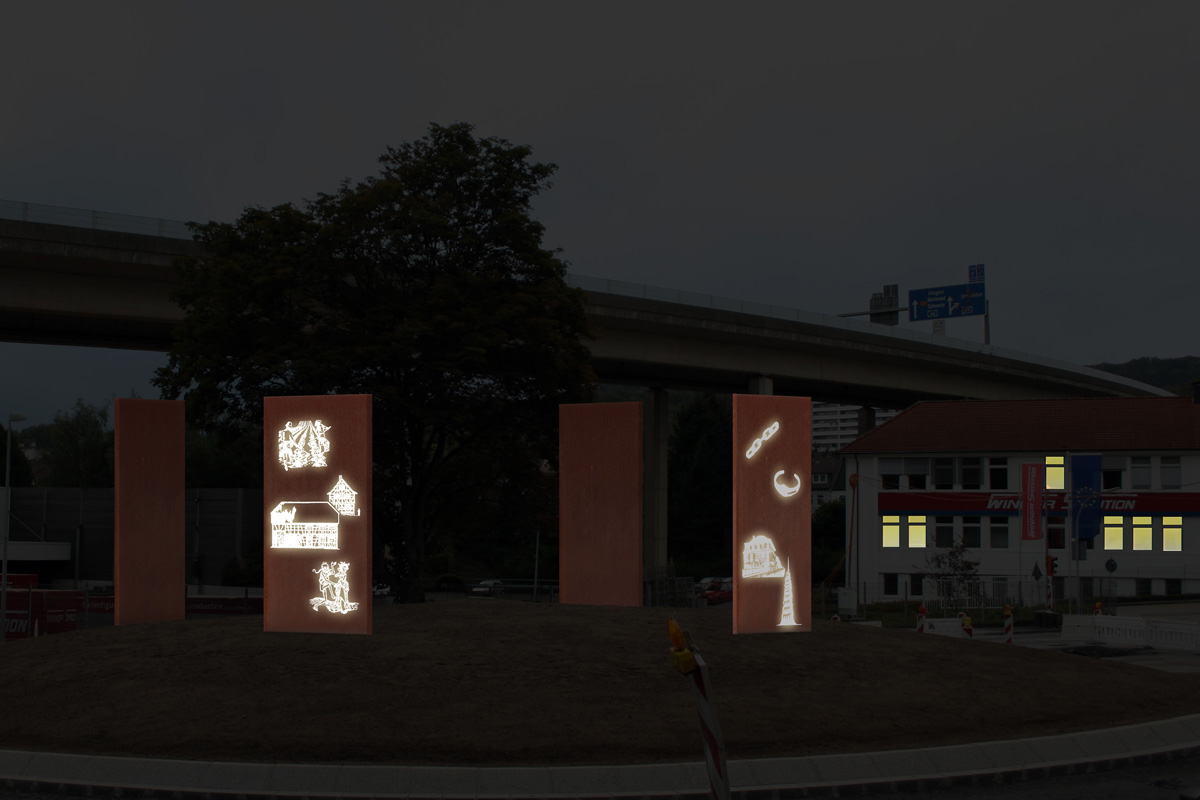
Design for an art object for a roundabout
Frank Haase
Design for an art object for a roundabout in Iserlohn-Oestrich
Art in public space: Cortenstahl, 2015
4 Stelen 110 x 220 cm
– Unrealized competition contribution –
Art object for a roundabout in Oestrich
Es ist mittlerweile zu einer üblichen Praxis geworden, den Freiraum von Kreisverkehren zur Installation von Kunstobjekten zu nutzen. Im Jahr 2012 beteiligte ich mich an einem Ideenwettbewerb zur Gestaltung des neuen “Kreisels” im Iserlohner Ortsteil Oestrich. Der Kreisverkehr an der Kreuzung am Autobahnzubringer zur A 46 stellt für Anreisende, sowohl über die Autobahn als auch über die B 236 aus dem Lennetal, ein Eingangsportal nach Oestrich dar. In dieser exponierten Lage übernimmt der Kreisel die Funktion ein Stadttores, das eine deutlich sichtbare Abgrenzung zwischen innen und außen, Ort und Umland darstellt.
It has now become a common practice to use the space around roundabouts to install art objects. In 2012 I took part in an ideas competition for the design of the new “roundabout” in the Iserlohn district of Oestrich. The roundabout at the junction at the motorway feeder to the A 46 is an entrance portal to Oestrich for those arriving via the motorway as well as the B 236 from the Lennetal. In this exposed location, the roundabout takes on the function of a city gate, which is clearly visible delimitation between inside and outside, place and surrounding area.
Also attractive at night
Here is the chance to use an object to draw attention to the history of the village and its peculiarities and sights. The installation welcomes those arriving and becomes a final sign of the village, with which departing people are bid farewell on their journey. My suggestion was to install steles corresponding to the four roads leading to the roundabout. Steles are distinctive landmarks and are often associated with historical contexts. The surfaces were supposed to carry artistically processed scenes of Oestrich history and stylized representations of Oestrich buildings. Ideally, the images could have been backlit at night using energy-saving LED technology.
Comprehensive picture of village life
Um eine breite Akzeptanz in der Öffentlichkeit zu erzielen, sah der Entwurf die grafische Aufarbeitung zahlreicher Themen aus dem Dorf vor. So sollten beispielsweise beide Kirchen, die Appeltatenkirmes mit ihrer langen Geschichte, aber auch Vereine und andere Interessengemeinschaften berücksichtigt und bildhaft dargestellt werden. Eben alles, was Oestrich als aktives und lebenswertes Dorf auszeichnet. So erzählen die Stelen bildhaft von der wechselvollen und langen Geschichte des Dorfes Oestrich – von den Rentierjägern der Mittelsteinzeit über die Ackerbauern, den Oestricher Goldfund und die Pestepedemie bis hin zur Gegenwart mit der Appeltatenkirmes, den Oestricher Vereinen und Institutionen. Die Auswahl der Themen sollte der Ortsring Oestrich organisieren – die Darstellungen auf den Abbildungen oben und unten stellen daher nur Beispiele dar, die für eine mögliche Realisierung der Installation beliebig ersetzt oder ergänzt werden sollten.
In order to achieve broad public acceptance, the design provided for the graphic processing of numerous topics from the village. For example, both churches, the Appeltatenkirmes event with its long history, but also associations and other interest groups should be taken into account and represented graphically. Everything that distinguishes Oestrich as an active and livable village. The steles tell graphically of the eventful and long history of the village of Oestrich – from the reindeer hunters of the Mesolithic to the arable farmers, the Oestrich gold find and the plague epidemic to the present day with the Appeltatenkirmes, the Oestrich associations and institutions. The Oestrich “Ortsring” should organize the selection of topics – the representations in the images above and below are therefore only examples that should be replaced or supplemented as required for a possible implementation of the installation.
Simple implementation and maintenance-free technology
The technical implementation is simple. Welded steel frames are clad with corten steel plates on the front and back. The motifs, created as dxf files, serve as the basis for the laser cut. A company that masters this technology is located in the Oestrich area. Backlit, translucent PMMA panels can optionally be backlit with LED technology to give the top an attractive visual appearance even at night. The LED technology, also offered by domestic companies, is energy-saving, has a long service life and is maintenance-free.
Information board for explanation
To explain the motifs, I recommended installing a stainless steel information board at a suitable location on the sidewalk, on which the motifs are repeated and described in short texts. The draft just missed a majority in the vote and was therefore not implemented.






